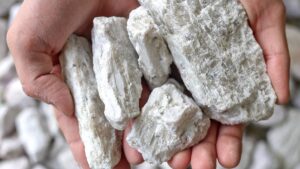Resources Rising Stars: Pilbara Minerals reckons there’s still fuel in the lithium price rocket

Pilbara Minerals says it is embarking on an incredibly impressive chapter with the lithium boom continuing despite some shocks along the way. Pic: Getty Images
- PLS ‘inundated with enquiries’ as investor appetite for lithium continues
- LTR says the company is ‘deep in discussions’ with a third potential off-taker
- ESS’ Pioneer Dome Project is one of only 13 spodumene resources in Australia
Pilbara Minerals (ASX:PLS) says it is embarking on an incredibly impressive chapter with the lithium boom continuing despite some shocks along the way.
While acknowledging the absolute confusing week investors have been put through, new PLS MD and CEO Dale Henderson shared his macro-observations as a key participant in the supply chain.
“The recent argument is that lithium supply is coming in spades from Africa – we would caution that, and the other argument is that it is coming from lithium lepidolite… we would caution that too,” he said.
“Lepidolite is not straightforward to process and if it was easy, it would have happened by now. I also would have expected some of the big lithium chemical producers to have bought assets there, which hasn’t happened, so I caution that.”
In terms of the long-range horizon for lithium supply and demand, Henderson said this is the establishment of a new industry.
“If I think back to 2017, when I first started with Pilbara, the sky was bright, lithium was the new oil and within seven months we commenced the downhill side, which was two years of survival contraction.
“Fast forward to 2020 and it is a completely different story – by this point Europe launched out the blocks and really got going with EV subsidies, production and so on and so forth, then North America kicked into gear particularly with the Biden administration coming in.
“I reference that short, history over the past five years to highlight this massive shift in the demand side of the equation and no one is questioning that.
“There seems to be strong agreement that lithium is that key ingredient of choice for battery chemistries going forward.”
But it is the short-term horizon, he says, that is looking particularly “very, very strong.”
“We are inundated with enquiries and the most meaningful example is our latest materials exchange auction,” he said.
Towards the end of May, the company pulled in US$5955/t for a shipment of 5.5% Li2O concentrate, destined for the Asian battery market.
That offer masks the true value of the sale given standard contract and spot pricing is conducted on a 6% Li2O basis. And on that measure, PLS is getting paid the equivalent of US$6,586/t for the 5000dmt cargo.
“What’s more, the phone kept ringing – there was a clamouring in the auctions to secure that tonnage and there were others following up saying ‘how can we get some, can we match that price’.
“That was as little as 15 days ago, so you be the judge about the current market and the appetite we have here.”
Liontown Resources (ASX:LTR)
The onetime penny stock turned $3.5 billion ASX 200 company is headed up by mining entrepreneur Tim Goyder and former senior BHP executive Tony Ottavino – who, at the Resources Rising Stars Conference yesterday, said he was “blessed to have walked into a company with an asset of this quality”.
LTR’s November 2021 DFS for the Kathleen Valley Project, north of Kalgoorlie in Western Australia, outlined a project capable of delivering returns at an assumed spodumene price well below the current spot price of ~US$5,000/tonne, which given the pricing seen by PLS is looking decidedly conservative.
“We believe we have this project timed to perfection,” he said.
“I am fortunate enough to have a resource I can build and then develop on the back of some excellent exploration activity.”
The $473 million mine will produce an initial 511,000tpa of 6% spodumene concentrate starting in 2024, ramping up to 658,000tpa after a couple of years.
Ottavino said the near-term producer is in “deep discussions” with a third potential off-take partner after signing two big deals – one with LG back in January and another earlier this week with the world’s number one EV manufacturer, Tesla, which saw its share price jump to $1.32.
“We have been deliberate on our off-take strategy,” he said.
“We learnt from the mistakes of the first-generation lithium producers, the quality of your counterparty is crucial – and where they sit on the value chain is also crucial.”
But LTR is more than just a single asset operation, he said.
“The Buldania asset is a very strategic asset for us – we will continue drilling at Kathleen Valley before moving to Buldania later in the year.
“This will form future, strategic mineral inventory on the back of our downstream refinery aspirations.”
When it comes to lithium supply and demand, Ottovino said deficit prevails.
“Every day my team and I meet with customers who are prepared to sign billions of dollars in take or pay contracts.
“I can see their eyes across the table, if I’m an EV executive sitting in a boardroom in Munich or San Fransisco and I’m banking my EV strategy on long term reliable supply, they will look to Australia.
“They will look at ESG and they will look at governing law – so that’s my position on supply and demand, deficit prevails.”
Essential Metals (ASX:ESS)
Junior lithium play ESS owns the 100% owned Pioneer Dome Lithium Project north of Norseman in WA’s “lithium corridor”.
Activities are underway to get the Dome North resource ready for development in parallel with exploration activities, which are designed to grow lithium resources beyond the 11.2Mt at 1.21% LI2O currently found at the project.
Managing director Tim Spencer said what sets the newcomer out from the rest is that Pioneer Dome represents one of only 13 spodumene JORC mineral resources in Australia, and the only Australian lithium resource not yet committed under an off-take arrangement.
In an interview with Stockhead on the sidelines of the Resources Rising Stars Conference, he said he is not a big believer in thinking there will be hundreds of lithium deposits found in Australia anytime soon.
“Our project is the only greenfield discovery in that it has never been drilled before and was found on first principles,” he said.
In terms of market sentiment, Spencer said the last 12 months has been a reinforcement of the true, long term thematic of lithium.
“There are more believers in it and the fundamentals have been strong – the concentrate prices have reached all-time records and I suspect that the most recent correction is due to the old thing of ‘things that go really high eventually have to come back down’.”
Related Topics

UNLOCK INSIGHTS
Discover the untold stories of emerging ASX stocks.
Daily news and expert analysis, it's free to subscribe.
By proceeding, you confirm you understand that we handle personal information in accordance with our Privacy Policy.








